It was May 2019 when Lenovo first announced that it was working on a PC with a holdable OLED display. The company showed me the product in its early stages, and at the time, there were specific things that we were allowed to say and things we couldn't. For example, the company showed us the keyboard, but that news wasn't going public on day one.
We could say that it was going to be Windows-powered, but not Windows 10-powered. Of course, at that time, Windows 10X was a rumor called Windows Lite, and Microsoft didn't have official branding for it. But when the product was announced as the ThinkPad X1 Fold, it ended up being a Windows 10 Pro device. A Windows 10X version was supposed to come later, as Lenovo proudly showed off at CES, but Windows 10X plans have changed. As it stands, we should consider this a Windows 10 product.
So at this point, you might be wondering if the product is useful. After all, the real question is, why have a foldable display on a Windows PC? Well, this is one of those products that I fell in love with quite quickly, and while it's far from perfect, I could feel the potential. Besides, at $2,499, this is a first-gen product at first-gen pricing.
That's what this review is going to add up to. I love it for various reasons that I'm going to describe, but I couldn't imagine paying $2,499 for it.
Specs
| CPU | Intel Core i5-L16G7 Core Processor with Intel Hybrid Technology 3.0 GHz |
|---|---|
| GPU | Intel UHD Graphics |
| Display | 13.3” Flexible QXGA OLED 4:3 (2048 x 1536, 300 nit), DCI-P3 95%, Touch |
| Body | Unfolded: 299.4x236.0x11.5mm (11.8x9.3x.45”) Folded: 158.2x236.0x27.8mm (6.23x9.3x1.09”) 999g (2.2 lbs) |
| RAM | 8GB LPDDR4 |
| Storage | 256GB PCIe-NVMe M.2 2242 SSD |
| Battery | 50Wh (Battery Life: 8.5 hours MobileMark 2018 & 10.4 hours video playback) |
| Connectivity | Wi-Fi 6 WLAN 802.11 AX Bluetooth 5.1 |
| Ports | (2) USB 3.2 Type C Gen 2 (1) Micro-SIM card slot |
| Camera | 5MP HD RGB, IR camera |
| Audio | Dolby Atmos Speaker System |
| Keyboard and pen | Lenovo Fold Mini Keyboard- Bluetooth, Wirelessly Charged (Bundled or Separately) Lenovo Mod Pen- Premium AES 2.0, Li-On |
| Material | Aluminum, Magnesium, Leather Cover |
| Color | Black |
| OS | Windows 10 Pro |
| Price | $2,799 |
Note that you can have this configured with 4G LTE, 5G, and up to a terabyte of storage. What you can't adjust is the Core i5 CPU and the 8GB of RAM. The specs above are actually for the base model, which is $2,499, plus the keyboard, pen, and the upgrade to Windows 10 Pro.
Day one
Design
The ThinkPad X1 Fold, when it's closed, looks like a closed, leather-bound book. Like almost all ThinkPads, it comes in any color that you want, as long as it's black. You'll notice a ThinkPad X1 logo in the top-right of the leather cover, but you'll also see that when it's closed, the leather doesn't cover the whole device. That's because it retracts when you close it.

On the other side, there's actually a kickstand that folds out. That's because there are several different form factors in which you can use the X1 Fold. Yes, you can use it in split-screen mode as a small laptop, but you can also unfold it and stand it up, using the Bluetooth keyboard.

The ThinkPad X1 Fold weighs in at 2.2 pounds, making it particularly light, especially with aluminum components and a leather cover. I assume that Lenovo wanted to hit the under a kilogram mark, making it 999g. It's comfortable to carry around, but keep in mind that it won't fit in most pockets. I found it to be just too big to fit into pockets on my cargo pants, which are the kind of pants I'm accustomed to wearing because I carry so many devices. It did fit in my jacket pocket though. In general, assume that you need to put it in a bag to carry it around.

You'll notice that the ThinkPad X1 Fold does have a gap in the hinge, and yes, there are some weird software issues like the display not turning off properly when it's closed. After all, this is a Windows 10 Pro device, so the OS is not used to having a folding screen. Lenovo did do the best it could, and it's pretty good. We'll get into that later.
On the one side, there's a USB 3.2 Gen 2 Type-C port. Sadly, there's no Thunderbolt, a shame considering that this thing could really benefit from some external power like a GPU.

The gap can actually be filled with the keyboard, which is stored inside of the device. It does have a micro-USB port on it, which you can use for a wired connection or if you need a wired charge. After all, you don't have to use it with the ThinkPad X1 Fold. It's just a Bluetooth keyboard.

On the outside of the folded ThinkPad X1 Fold, you'll find the power button, a volume rocker, and another USB 3.2 Gen 2 Type-C port. Having this second USB port is actually very nice, because it lets you charge the PC from different places, and either one might be more convenient depending on how you're using it. You'll also notice that there's a slug where the nano-SIM card slot would be, since Lenovo uses the same chassis for all configurations.

I was very disappointed that Lenovo didn't send me a cellular unit, because one thing that I frequently did was test it out on the go, reading books and such while I was in waiting rooms or anywhere else. Using my phone as a hot spot just sounds like such a five years ago thing to do, and it's a real shame that cellular doesn't come standard on this.
One final thing about the design, and possibly the most important thing, is that this is a ThinkPad. That means that like all ThinkPads, the X1 Fold passes 12 military-grade certification methods and 27 procedures. It's MIL-STD-810H certified, and Lenovo said that it ran even more tests with the ThinkPad X1 Fold to make sure it can handle being open and closed thousands of times, that it can handle the display closing on an object that got stuck inside, and more.
Display and audio
The Lenovo ThinkPad X1 Fold has a 13.3-inch 1536x2048 foldable OLED display. It folds into two 9.6-inch 3:2 displays, and you can use it in a variety of form factors. You can use it as two screens side by side, as one big screen, or you can use it as a laptop.

Yes, you can magnetically attach the keyboard to the inside, and the display automatically adjusts to it. You just get a little 9.6-inch laptop that way. You will notice that the webcam ends up being on the side rather than the top, and things can get a bit awkward.
Things can get a little glitchy when it comes to the orientation of the device. Windows 10 Pro is not built for having folding screens, so at times, it's like the device doesn't know which way is up. I'll be holding it reading a book and the slightest adjustment could send it into thinking I'm trying to use it as a laptop. This is likely something that would have been resolved in Windows 10X. Lenovo tried to help with its Mode Switcher software, and it's probably as good as it can be without an OS that's designed for it.

The OLED display is beautiful, and of course, the fact that it folds is super-cool. You can use one side to read a book and the other to take notes, or you can use it as a book with a page on each side. I actually really like the foldable aspect of the display, and prior to actually using it, I'd have said that it doesn't make any sense at all. Being able to go from a 13.3-inch full-screen device to a 9.6-inch laptop to a dual-screen device makes it incredibly versatile.
I also think that this is the smarter move versus what Microsoft was promising in the Surface Neo. The Neo was set to have two separate screens, and while that probably makes it a bit tougher than a folding screen, you can't unfold it into a single, larger screen.

The audio quality isn't particularly impressive. Lenovo touts Dolby Atmos, but the sound is tinny. The speakers are also on one corner of the device, and part of it is pointing down if you're using it with the kickstand. It's not very loud either. It's a real shame, especially since there's no 3.5mm audio jack on the ThinkPad X1 Fold.
Keyboard and touchpad
There is good news and bad news with the keyboard. The bad news is that it's tiny. It's hard to type comfortably on; that's the nature of small laptops. What it's not the nature of, typically, is a full-size 13-inch device, and that's what this can be. The good news is that it's a Bluetooth keyboard, and you can use any keyboard you want. You can even use this small keyboard while you're on the go, and a larger Bluetooth keyboard when you're back at the office and ready to set up the larger screen.

Moreover, keep in mind that the ThinkPad X1 Fold base model doesn't even come with the keyboard. The keyboard and pen combo comes in a separate configuration that costs $250 more, meaning that if you don't opt in for it, you can just go and get any variety of third-party products. Of course, this is the only one that fits inside of the folded display and attaches via a magnet.
Let's also talk about the design of the keys. To my knowledge, it's the first ThinkPad-branded device to have a keyboard that does not have a TrackPoint, that little red nub that can control the pointer. This is very interesting to me, because Lenovo had to have made a choice here, and chosen a touchpad instead. It almost makes more sense on such a compact device to have a TrackPoint and physical buttons.

Just like the keyboard, the touchpad is tiny. It works fine enough, or at least as fine as it can given the size. Lenovo doesn't like to make any real changes to those ThinkPad features like the TrackPoint, because they have their die-hard fans. You'll also notice that the Ctrl button is to the left of the Fn button, another ThinkPad rarity.

Pen input is surprisingly good. I expected it to be somewhat uncomfortable given the nature of the display, but it's not. Taking notes on this device was a real pleasure.
But the input experience on this device is something that definitely has to be worked on for the second generation. I love the idea of a portable device that can be my on-the-go companion and then can be unfolded into a full-size laptop, but it needs to have a full-size keyboard as well. I'm reminded of Microsoft's foldable keyboard, and I wonder how a similar keyboard would work with a device like this one.
Performance and battery life
The Lenovo ThinkPad X1 Fold is a very cool and interesting device because of its foldable display, but there's something else about it that would be stealing the show if it wasn't for the screen: the Intel Lakefield CPU. It's one of the first PCs to use Intel's new Hybrid Technology.
Intel's Hybrid Technology is the company's attempt to compete with ARM. For years, ARM chips have used big.LITTLE architectures, where you'll get big, powerful cores that handle power-hungry tasks, and you'll get small, efficient cores for tasks that don't need it, like an always-on display or syncing notifications. Intel is calling its implementation of this big-bigger, probably because it doesn't want to admit that it can do anything little.

Still, there's really nothing big about this. Intel's Lakefield processors have one prime core and four small cores, and the one prime core has a 7W TDP, so at its best, it's similar to a Y-series processor. Don't even imagine trying to run something like Photoshop on here, even for light tasks.
Battery life isn't great either, or not nearly what I'd expect for something with a brand-new power management strategy from Intel. I'd really love to see an ARM processor in the second generation of this product. With a Qualcomm Snapdragon 8cx under the hood, this thing would feel a lot better to use.
This CPU is engineered for productivity work. If you do most of your work in the browser, you're in good shape. Of course, the bad news there is that the X1 Fold only comes with 8GB RAM; there are no other configurations for that. If you're like me and you have tons of tabs open, along with some other apps like Skype, OneNote, Slack, and more, you might wish that you had a bit more.
For benchmarks, I used PCMark 8, PCMark 10, and Geekbench.
| ThinkPad X1 Fold Core i5- L16G7 |
Acer Swift 7 Core i7-8500Y |
HP Spectre Folio Core i7-8500Y |
Samsung Galaxy Book S Snapdragon 8cx |
Surface Pro X SQ2 |
Huawei MateBook E Snapdragon 850 |
|
|---|---|---|---|---|---|---|
| PCMark 8: Home | 2,521 | 2,440 | 2,727 | |||
| PCMark 8: Creative | 2,300 | 2,427 | 2,773 | |||
| PCMark 8: Work | 2,899 | 2,732 | 3,242 | |||
| PCMark 10 | 2,292 | 2,775 | ||||
| Geekbench 5 | 510 / 1,727 | 726 / 2,909 | 794 / 3,036 | 494 / 2,045 |
Note that I only ran Geekbench on the ARM-powered PCs, since there aren't many ARM-native benchmarking applications. I had to go back to the Snapdragon 850 to find something comparable on Geekbench, and eighth-generation Y-series, while seemingly still superior in most ways, was the best I could do for comparable performance from another Intel chip.
Conclusion
The Lenovo ThinkPad X1 Fold has just so many flaws, but boy do I love it. When I started using it, I immediately felt like this could be something great. It's just a delight. But then the bugs start to kick in. I started getting annoyed by the tiny keyboard, and a big frustration for me was that it didn't have cellular.
This was a device that I tried to take everywhere with me. It feels like something that can be what you want it to be. It can be a book, a tablet, a laptop, anything. So when I pull it out to do the thing I want it to do on the go, it better be connected to the internet.

Now, that's where the price comes in. I couldn't find any cellular models on Lenovo's website, although it should come with 5G at some point. The ThinkPad X1 Fold starts at $2,499, and that comes with the Core i5 and 8GB RAM that's in every configuration, and 256GB of storage. The next configuration up is $2,749, and the only change is that it comes with a pen and a keyboard. The next configuration is $2,799, and that adds on Windows 10 Pro instead of Home. $2,899 gets you 512GB of storage, and $3,099 gets you 1TB.
So, assuming that cellular connectivity comes at a $100 premium, which is not a number that I've confirmed with anyone, this unit would be $2,899. If I wanted a proper amount of storage, that's $2,999. And as much as I love the ThinkPad X1 Fold, it's just not worth it.
Here's to hoping that the next generation will be worth it. Hopefully, the price of folding displays comes down, and Microsoft gets Windows 10X out the door for devices like this. If you do want to check out the X1 Fold, you can find it here.
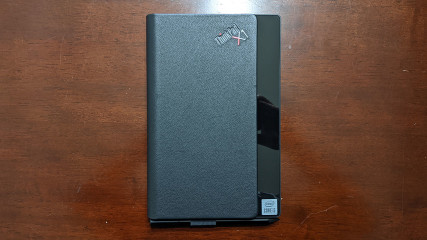


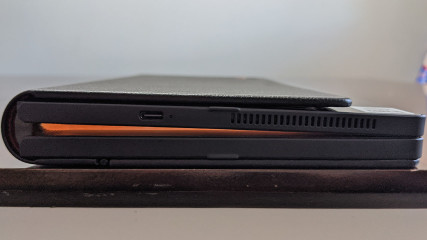
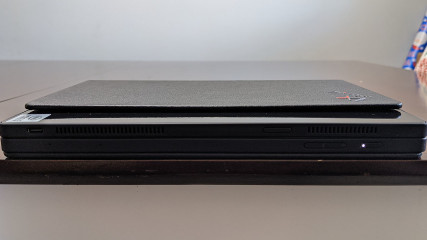


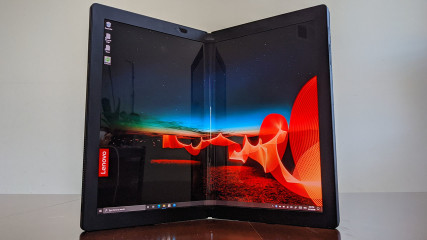


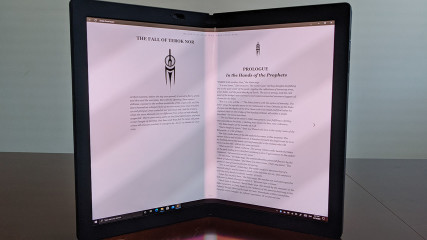

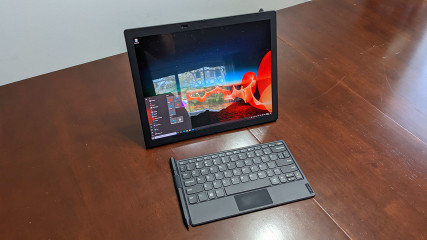
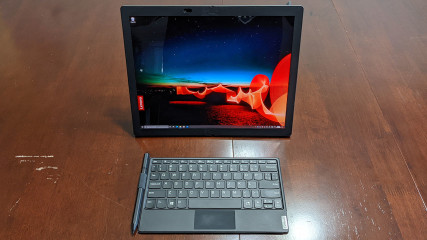
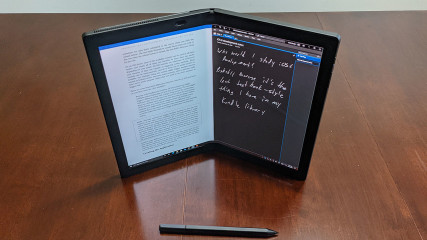
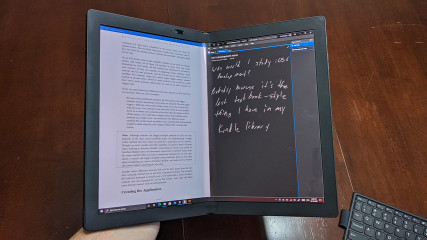


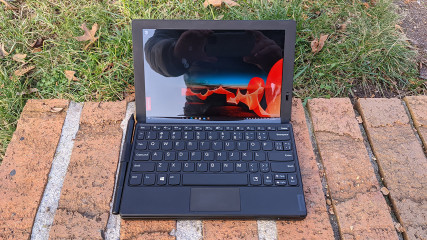
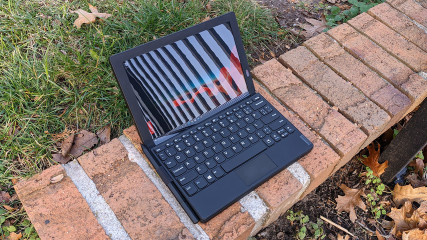

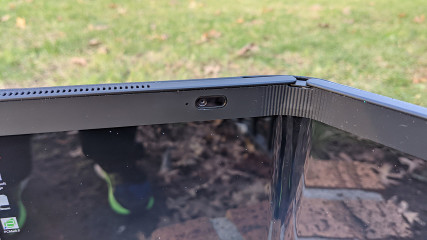









10 Comments - Add comment